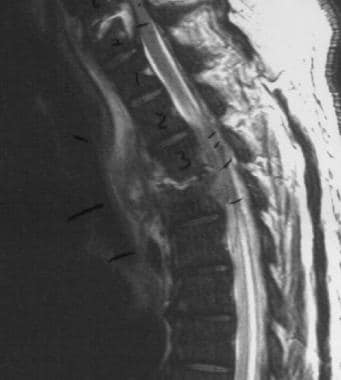Background
Epidural and subdural infections are similar in that both are suppurative infections that may cause clinical problems by extrinsic compression of CNS structures. They differ in almost all other ways. Both are unusual and are often discovered in the course of investigation for other more common clinical entities.
Approximately 90% of epidural infections are located along the spinal neuraxis and cause symptoms referable to the spinal cord. In contrast, 95% of subdural infections are located intracranially with a predilection for frontal lobe involvement. The unusual intracranial epidural infection is often associated with an intracranial subdural infection. [1]
For purposes of this discussion, epidural infection is considered synonymous with spinal epidural abscess, and subdural infection is considered synonymous with intracranial subdural empyema, unless otherwise noted.
Pathophysiology
Epidural infection, by definition, involves the epidural space between bone and dura. This is a true space in the spinal canal that is filled posteriorly with epidural fat, small arteries, and a venous plexus. Infections tend to spread over several vertebral levels. Anteriorly, the spinal epidural space is a potential space because the dura adheres tightly to the vertebral body. Abscesses are more frequent in the larger posterior epidural space.
Hematogenous spread with seeding of the epidural space is the suspected source of infection in most children and is thought to occur in many adult cases as well. Reported sources of seeding are numerous and include endocarditis, infected indwelling catheters, urinary tract infections, abdominal infections, and others. Direct extension of infection from vertebral osteomyelitis occurs in adults but rarely in children. A source of infection is not identified in many patients. Spinal epidural abscess following epidural steroid injection and epidural catheter placement has been reported. [2] A recent outbreak of fungal infections associated with epidural injections of contaminated methylprednisolone also included epidural abscesses. [3]
Spinal epidural abscesses in the thoracic spine may progress more quickly and have more severe consequences. This is believed to result from the relatively small size of the spinal canal compared to other spine levels. [4]
See the image below.
 Spinal epidural abscess with cord edema and compression. Abscess extends into paravertebral tissues.
Spinal epidural abscess with cord edema and compression. Abscess extends into paravertebral tissues.
The effects of epidural abscess are often from involvement of the vascular supply to the spinal cord and subsequent infarction rather than from direct compression. [5]
Subdural infections (eg, subdural empyema) occur beneath the dura. Infection spreads over the brain and may penetrate into the parenchyma of the brain or may cause diffuse cerebral edema. These infections frequently result from direct extension from paranasal sinusitis (most common), otitis media, or mastoiditis; from complications of neurosurgical procedures including craniotomies; or, less commonly, from posttraumatic extra-axial hematomas.
Epidemiology
Frequency
United States
The incidence of spinal epidural abscesses has nearly doubled over the last 50 years, possibly because of increased intravenous drug abuse, increased spinal operative procedures, an aging population, and increased sensitivity of detection using MRI. [6] Reported incidence ranges from 0.2-1.2 cases per 10,000 hospital admissions up to 12.5 cases per 10,000 admissions at a tertiary care center. [7] A recent population study of spontaneous epidural abscess in Olmsted County, Minnesota, found the incidence to be 0.88 cases per 100,000 person-years. [8]
No clear estimate of frequency for subdural empyema exists, but it is uncommon. Subdural empyema is said to account for 15-25% of pyogenic intracranial infections. Extrapolating from frequency figures for brain abscess yields roughly 1-2 cases per 10,000 admissions to a tertiary care center.
Mortality/Morbidity
Spinal epidural abscesses are, in themselves, not fatal. However, with complications and associated conditions, mortality rates of 5-23% are reported. [1]
Most case series of subdural empyema report mortality in the 30% range. A declining mortality rate in recent years has been reported. [9] This disorder was uniformly fatal in the pre-antibiotic era.
Sex
No predilection exists with epidural abscess.
In subdural empyema, men are 3-4 times more commonly affected than women.
Age
Spinal epidural abscess may be found in all age groups; on average, patients are older than 50 years. Intravenous drug users with spinal epidural abscesses are, on average, aged 35 years.
Subdural empyema may occur at any age but is most frequent in the second and third decades of life.
Recent pediatric case series and reviews confirms that these entities do occur in children. [10, 11]
Prognosis
Fewer than half of individuals who survive spinal epidural abscesses fully recover. [12] Paraplegia or quadriplegia is a frequent sequela. Disability seems related to severity and duration of symptoms prior to institution of therapy. A spinal rehabilitation program may be necessary to minimize long-term problems.
Acute subdural empyema fatality rate is about 40%. About 40% of survivors develop a seizure disorder, either in the acute phase or during convalescence.
-
Spinal epidural abscess with cord edema and compression. Abscess extends into paravertebral tissues.







